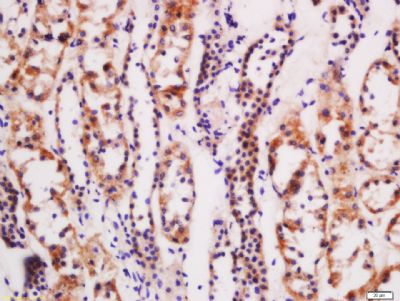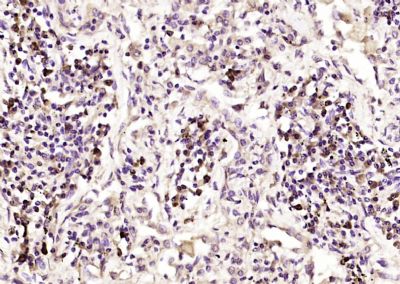CTR1 Polyclonal Antibody
Purified Rabbit Polyclonal Antibody (Pab)
- 产品详情
- 实验流程
Application
| IHC-P, IHC-F, IF, ICC, E |
|---|---|
| Primary Accession | O15431 |
| Reactivity | Rat, Pig, Bovine |
| Host | Rabbit |
| Clonality | Polyclonal |
| Calculated MW | 21091 Da |
| Physical State | Liquid |
| Immunogen | KLH conjugated synthetic peptide derived from human CTR1 |
| Epitope Specificity | 51-150/190 |
| Isotype | IgG |
| Purity | affinity purified by Protein A |
| Buffer | 0.01M TBS (pH7.4) with 1% BSA, 0.02% Proclin300 and 50% Glycerol. |
| SUBCELLULAR LOCATION | Cell membrane. Localizes to the apical membrane in intestinal epithelial cells. |
| SIMILARITY | Belongs to the copper transporter (Ctr) (TC 1.A.56) family. SLC31A subfamily. |
| SUBUNIT | Homotrimer. |
| Post-translational modifications | O-Glycosylation at Thr-27 protects from proteolytic cleavage in the N-terminal extracellular domain. |
| Important Note | This product as supplied is intended for research use only, not for use in human, therapeutic or diagnostic applications. |
| Background Descriptions | The protein encoded by this gene is a high-affinity copper transporter found in the cell membrane. The encoded protein functions as a homotrimer to effect the uptake of dietary copper. [provided by RefSeq, Aug 2011] |
| Gene ID | 1317 |
|---|---|
| Other Names | High affinity copper uptake protein 1, Copper transporter 1, hCTR1, Solute carrier family 31 member 1, SLC31A1, COPT1, CTR1 |
| Dilution | IHC-P=1:100-500,IHC-F=1:100-500,ICC=1:100-500,IF=1:100-500,ELISA=1:5000-10000 |
| Format | 0.01M TBS(pH7.4) with 1% BSA, 0.09% (W/V) sodium azide and 50% Glyce |
| Storage | Store at -20 °C for one year. Avoid repeated freeze/thaw cycles. When reconstituted in sterile pH 7.4 0.01M PBS or diluent of antibody the antibody is stable for at least two weeks at 2-4 °C. |
| Name | SLC31A1 (HGNC:11016) |
|---|---|
| Function | [High affinity copper uptake protein 1]: Uniporter that mediates the transport of copper(1+) from the extracellular space to the cytoplasm, across the plasma membrane (PubMed:11734551, PubMed:16135512, PubMed:17525160, PubMed:19740744, PubMed:20451502, PubMed:20569931, PubMed:23658018) and delivers directly copper(1+) to specific chaperone such as ATOX1, via a copper(1+)- mediated transient interaction between the C-terminal domain and a copper(1+) chaperone, thus controlling intracellular copper(1+) levels (PubMed:11734551, PubMed:16135512, PubMed:17525160, PubMed:19740744, PubMed:20451502, PubMed:20569931, PubMed:23658018, PubMed:26745413). May function in copper(1+) import from the apical membrane thus may drive intestinal copper absorption (By similarity). The copper(1+) transport mechanism is sodium-independent, saturable and of high-affinity (PubMed:11734551). Also mediates the uptake of silver(1+) (PubMed:20569931). May function in the influx of the platinum- containing chemotherapeutic agents (PubMed:20451502, PubMed:20569931). The platinum-containing chemotherapeutic agents uptake is saturable (By similarity). In vitro, mediates the transport of cadmium(2+) into cells (PubMed:33294387). Also participates in the first step of copper(2+) acquisition by cells through a direct transfer of copper(2+) from copper(2+) carriers in blood, such as ALB to the N-terminal domain of SLC31A1, leading to copper(2+) reduction and probably followed by copper(1+) stabilization (PubMed:30489586). In addition, functions as a redox sensor to promote angiogenesis in endothelial cells, in a copper(1+) transport independent manner, by transmitting the VEGF- induced ROS signal through a sulfenylation at Cys-189 leadin g to a subsequent disulfide bond formation between SLC31A1 and KDR (PubMed:35027734). The SLC31A1-KDR complex is then co-internalized to early endosomes, driving a sustained VEGFR2 signaling (PubMed:35027734). |
| Cellular Location | Cell membrane; Multi-pass membrane protein. Early endosome membrane; Multi-pass membrane protein. Recycling endosome membrane; Multi-pass membrane protein. Apical cell membrane {ECO:0000250|UniProtKB:Q8K211}; Multi-pass membrane protein. Late endosome membrane {ECO:0000250|UniProtKB:Q8K211}; Multi-pass membrane protein. Basolateral cell membrane {ECO:0000250|UniProtKB:Q8K211}; Multi-pass membrane protein. Note=The localization is controlled by the intra and extra-cellular copper concentration (PubMed:15326162, PubMed:19740744, PubMed:23658018, PubMed:26205368, PubMed:26945057). Under conditions of elevated extracellular copper concentrations, it is rapidly internalized by endocytosis from the plasma membrane by a clathrin- and dynamin-mediated process and degradated in order to prevent intracellular copper accumulation and to reduce the transport of the copper across the membrane (PubMed:15326162, PubMed:19740744, PubMed:23658018, PubMed:26205368, PubMed:26945057). The internalized SLC31A1 is then localized in early endosomes, and, upon a low extracellular copper concentrations, it is transported back to the plasma membrane in a RAB11A-dependent recycling pathway (PubMed:26945057). Localizes to the apical membrane in intestinal epithelial cells (By similarity). Mainly localized on the basolateral side of renal tubular cells (By similarity). Localizes to the neuronal cell body plasma membranes (By similarity) {ECO:0000250|UniProtKB:Q8K211, ECO:0000250|UniProtKB:Q9JK41, ECO:0000269|PubMed:15326162, ECO:0000269|PubMed:19740744, ECO:0000269|PubMed:23658018, ECO:0000269|PubMed:26205368, ECO:0000269|PubMed:26945057} |
Research Areas
For Research Use Only. Not For Use In Diagnostic Procedures.
Application Protocols
Provided below are standard protocols that you may find useful for product applications.
终于等到您。ABCEPTA(百远生物)抗体产品。
点击下方“我要评价 ”按钮提交您的反馈信息,您的反馈和评价是我们最宝贵的财富之一,
我们将在1-3个工作日内处理您的反馈信息。
如有疑问,联系:0512-88856768 tech-china@abcepta.com.
¥ 1,500.00
Cat# AP54312























 癌症的基本特征包括细胞增殖、血管生成、迁移、凋亡逃避机制和细胞永生等。找到癌症发生过程中这些通路的关键标记物和对应的抗体用于检测至关重要。
癌症的基本特征包括细胞增殖、血管生成、迁移、凋亡逃避机制和细胞永生等。找到癌症发生过程中这些通路的关键标记物和对应的抗体用于检测至关重要。 为您推荐一个泛素化位点预测神器——泛素化分析工具,可以为您的蛋白的泛素化位点作出预测和评分。
为您推荐一个泛素化位点预测神器——泛素化分析工具,可以为您的蛋白的泛素化位点作出预测和评分。 细胞自噬受体图形绘图工具为你的蛋白的细胞受体结合位点作出预测和评分,识别结合到自噬通路中的蛋白是非常重要的,便于让我们理解自噬在正常生理、病理过程中的作用,如发育、细胞分化、神经退化性疾病、压力条件下、感染和癌症。
细胞自噬受体图形绘图工具为你的蛋白的细胞受体结合位点作出预测和评分,识别结合到自噬通路中的蛋白是非常重要的,便于让我们理解自噬在正常生理、病理过程中的作用,如发育、细胞分化、神经退化性疾病、压力条件下、感染和癌症。







